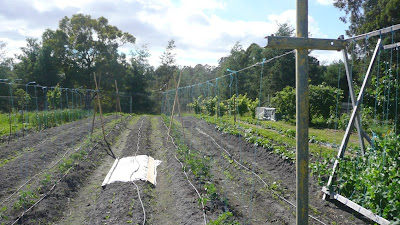We set steel posts into concrete at the end of each row. These were not set directly but into sleeves so that the posts could be removed at the end of the season for easy tractoring. 3.5mm wire was tensioned between the posts using a gripple.
Plants were spaced at 60cm directly under the wire.
Baling twine was wrapped around the base of each plant and then tied to the top wire to form a "V" with the plant at its vertex.
These plants are then trained to only two shoots. Here's how:
Find the first flower cluster and then locate the secondary shoot growing out in the "armpit" between the stem and the leaf just below the flower. This one plus the main shoot (that is growing on above the flower) are saved.
The extra shoot at the bottom is pinched off as are ALL other shoots. As the stems grow they are wound around the strings. This is much quicker and easier than using ties.
If the shoots make it to the top of the string, we'll just cut them off. This won't kill the plants and will allow all energy to be directed to fruit production.









